This year has been tougher for almost everyone — hiring freezes, budget cuts, layoffs, and macroeconomic headwinds.
For those in the business of getting customers for their companies, you might be expected to cut down on spend, yet you’re still expected to grow the company and find ways to sell.
Datadog CMO Alex Rosemblat took the stage at SaaStr Annual 2023 to share how marketing teams can get more deals done with less budget.
Was the operating mode of the past couple of years counterproductive or, at a minimum, less efficient for getting deals done?
Essential Skills to Survive and Thrive in this Macro-Economic Environment
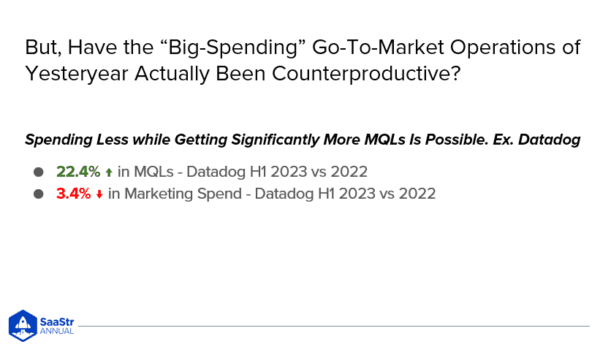
From the first half of this year to last year, Datadog spent just under 4% less on marketing spend.
At the same time, they got more than 20% more marketing-qualified leads for their sales team.
The composition of the leads changed, but that’s not easily expressed through numbers.
The good news?
There is a way to keep getting more top of funnel that turns into deals even if you’re spending less.
A couple of toolkit essentials to survive and thrive in this macroeconomic environment include:
- Prioritization
- Efficiency
- Pragmatism
During the Boom, there was always the illusion that you could throw money at a problem or that there was a magic bullet solution.
That’s off the table now, and you might have to break out the duct tape to fix things.
Prioritization: What Matters Most
A lot of attention is focused on how marketing can help influence sales. But it’s essential to see what’s going into the sales engine to begin with.
What is the input? The raw material?
The first question you need to ask yourself is:
Are you consistently giving your sales team great leads with high conversion potential?
Are they the right people? Are they the right companies? Are they the right people from the right companies?
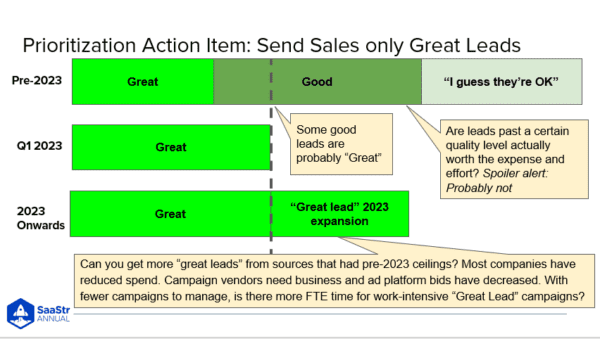
Pre-2023, the quality of leads or campaigns could be broken down into three general buckets.
- The great campaigns that kept giving leads that readily turned into sales.
- The questionable campaigns that looked good on paper but weren’t so great.
- The good leads that could become great leads with some tweaking.
Bucket two had to be cut. Questionable or “okay” campaigns aren’t worth your budget or a salesperson’s time.
After cutting the bad and optimizing the good, Datadog had some budget available to go toward things that were working consistently.
They doubled down on great lead sources to produce more great leads.
The takeaway — The bottom bar of fewer but higher quality leads was more conducive to getting customers than the top bar of more volume.
Another thing that happened after cutting spend was people had more time on their hands with fewer resources.
This unlocked a huge amount of creativity and almost a renaissance where ideas were flowing thanks to the shortage.
What Marketing KPIs Are You Measuring?
The next question to ask yourself about what’s going on in the top of the marketing funnel is:
Are your marketing KPIs and cost attribution taking deal progression into account?
Let’s look at an example.
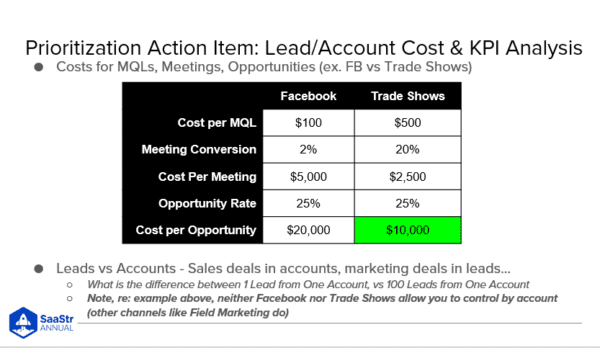
You can run two different types of campaigns to bring in leads: Facebook and tradeshows.
FB leads are low cost, but it’s anonymous people coming to you who might not know your company.
Trade shows, however, are expensive and time-intensive, but they might lead to customers more often than FB.
At a tradeshow, you meet someone in person, have a conversation, and potentially start the beginning of a deal while standing at your booth.
It takes fewer trade show leads to turn into a meeting, so the cost per meeting is lower.
Assuming that opportunity rates are the same, that means opportunities are significantly cheaper at a tradeshow, even if the upfront costs are higher.
Leads Only vs. Accounts
Are you looking at leads only or accounts, too?
Many in marketing are goaled on volume of people. If you get one or one hundred leads from the same company, that’s great!
But for a salesperson, one hundred leads from the same company will likely end up as a single deal.
So, if you pivot all of your cost accounting on an account basis, you might find that a lot of your programs that you thought were great aren’t actually performing as well as you thought.
Efficiency: What You Get Is What You Get
In a world of constrained budget, resources, and staffing, what you get is what you get.
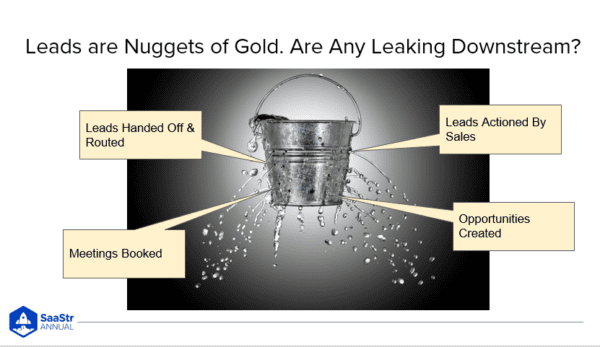
There are four distinct areas where marketing is involved in the sales process.
- When leads are handed off from marketing to sales
- When sales take those leads and take action
- When booking meetings
- When creating opportunities
If there’s a leak or hole in any of these handoff steps, nuggets of gold will fall out of the bucket and never turn into deals.
You need to look at conversion rates at every stage and, as a marketing team, ensure that the leads are being acted on and have a good chance of becoming deals.
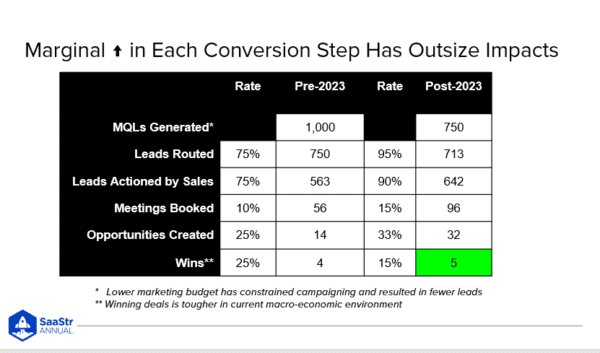
Improving the conversion rates can have an outsized impact on your deals.
Let’s take two scenarios.
In the pre-2023 column, the team produces 1,000 qualified leads per month.
Budget cuts came in, and 25% of that lead generation capacity is gone. So, post-2023, that organization is only getting 750 leads per month.
Pre-2023, three out of four leads made it to a sales rep, which isn’t terrible. Then, one out of ten turned into a meeting. That number should be higher.
So, out of 1,000 going in, only four came out.
Now, in 2023, there are almost double the meetings booked, which is a 3x improvement.
The takeaway — Even if the macro means winning a deal gets harder, you can bear the brunt of it with a tighter set of conversion metrics and get more deals with less budget.
Four Steps To Optimize for Efficiency In Marketing
There are four possible ways to optimize for efficiency.
- Lead Routing
Are all leads being generated making it to the right reps?
Key KPIs include:
- Unassigned leads
- Leads in queues
- “Open” lead aging
These are usually a systems and operations issue, and there are fixes.
Some of those include:
- KPI development
- Recurring managerial oversight
- Dedicated FTE to oversee lead routing
Sometimes, it’s challenging to pinpoint issues, so hiring a full-time employee to make sure all leads go to the intended recipients is helpful.
This is what Datadog did because it wasn’t one big issue interfering with lead routing. It was death by a thousand cuts.
- Sales acceptance and actioning
Are all leads getting worked on?
Key KPIs here include:
- Lead actioning rates and aging
- Lead rejection rate and reasons
Not every lead will be qualified. If a campaign isn’t working, you want to know what it is so you can discontinue it and reallocate that budget elsewhere.
This step is also an operational issue.
Some low-cost or no-cost fixes for lead actioning are:
- Engineering a CRM dashboard for every rep so every lead with their name on it is right in front of them.
- Team-specific lead actioning reporting to figure out which ones aren’t following up on leads and why.
- Recurring managerial oversight meetings
- Follow-up SLA and clawbacks to ensure leads are followed up within a set amount of days.
- Initial follow-up by SDRs.
When you ask why a team isn’t following up on leads, you can gain valuable insights into the quality of those leads or the quality of that team. If leads aren’t getting action, something is probably broken.
- Meeting conversion
Do leads want to pick up the phone and talk to your team at expected rates?
This is a training issue if reps don’t know the right language or what customers are looking for.
Some key KPIs to include here are:
- Meeting rate
- Sampling good vs. generic (or outright bad) emails and calls
If you have the bandwidth, sample emails in Salesforce or a sales listening tool like Gong to see what you find.
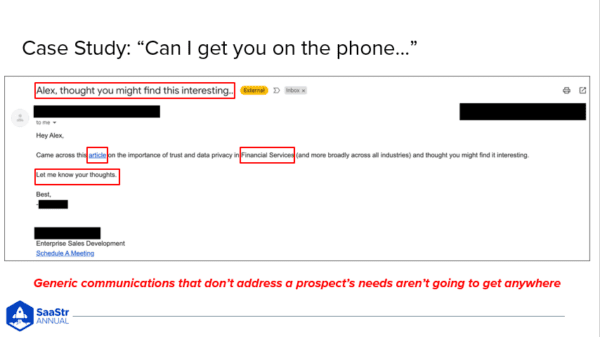
Rosemblat gets hundreds of these emails a day. If you look at the subject line, you have no idea what it’s about.
Inside, the person wants you to click on a random link, which is common for phishing scams.
If you sample emails and calls from your own sales team, you might find these generic sales emails might be the norm.
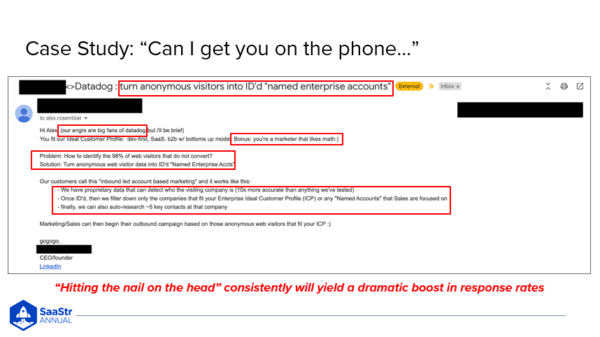
Now, look at this email that got an instant reply. They addressed the problem, shared about the company concisely, and answered Rosemblat’s questions immediately.
They had a demo within a day.
Some low-cost fixes for meeting conversions are:
- CRM + marketing automation data UI and training
- Demo certification program
- First call/email workshopping and certification
- Use your customer’s own words to get more customers
If you can hit the nail on the head with outreach like this, meeting rates should go up dramatically.
- Opportunity Creation
Can reps recognize potential deals?
This one is pretty basic and has a lot to do with training. Opportunity creation rates should be cut by product or geo as much as possible.
From marketing, some of the low-cost fixes include:
- Building a use case taxonomy or family tree of why people will open their checkbook and write you a check.
- Working backward from there and creating a playbook for every branch.
- Sampling meetings that didn’t turn into opportunities and creating use cases where they aren’t trained well enough.
Pragmatism: There is No Magic Bullet
There is no magic bullet, but when budgets were big, you could pretend there was.
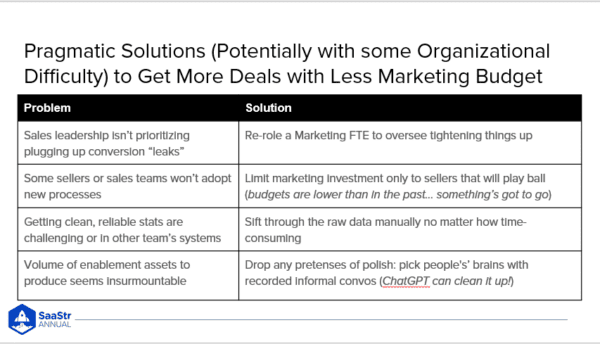
Some low-cost and no-cost solutions will help your company get more deals done with less budget.
- If you’ve identified leaks within a conversion step, plenty of marketing employees can roll out solutions to plug holes.
- When sales teams don’t want to change processes, and you’ve got a limited budget, you might want to limit or remove marketing budget or attention from that particular team.
- You can sift through raw data to get a baseline of whether your solutions are actually working or worth your time.
Knowledge is all you need.
Many of us have been pushed to spend, spend, spend until recently. But marketing budget isn’t the only factor in getting more customers.
If there’s one takeaway or action you can take from this article, it’s this…
Try to measure down-funnel conversion rates.
Are leads getting routed properly? Are they getting actioned? Meetings booked? Opportunities created?
You might find a world of optimization out there to pragmatically and quickly solve for to get way more deals on a way less budget.

